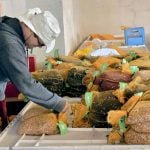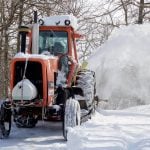Western Producer reporter Michael Raine is in Hanover, Germany all week at the Agritechnica show. Agritechnica is the worlds largest farm machinery show.
HANOVER, Germany — Just after dawn on the first day of September a single combine rolled into a wheat field near the town of Swaby in Lincolnshire, England. The grain was testing 18 percent, but would improve during the day.
Eight hours later and about 24,000 bushels (adjusted to 13.5 percent moisture) of wheat were in the bins and 172 acres were empty.
Farmers Mike Daniels and Tony Turnbull said it was the fastest their land had ever been harvested.
For Claas it was a 20,267 bushel record taken away from combine competitor New Holland. The machine was a Claas / Lexion 770, a 586 horsepower combine fitted with the Claas track system and a 40 foot Vario header.
Jens Broer was one of a pair of operators that worked in two hour shifts to break the three year old Guinness record.
“It went by very smoothly. It was fast and a bit (tough) in the morning, but the machine ran at full power the whole way,” he said after the announcement of the record at Germany’s Agritechnica in Hanover, the world’s largest farm show.
“We just set the (computerized throughput) controls and the machine for the changing conditions during the day, put on the GPS (steering) and watched it work until we needed to unload or turn,” said Broer.
Theo Freye of Claas’ board of directors said the machine wasn’t allowed to “just run through the field. The losses were 0.3 to 0.5 percent. They check that,” he said.
“But they decided not to stop. After six hours the eight hour record was broken, so they finished the fields. They ran 20 hours, through the night,” he said.
Almost 50,000 bushels (48,800 adjusted to 13.5 percent moisture), or $350,000 worth, of wheat would come off 320 acres by 6:30 the next morning.
“But it took four helpers to keep it (away) from the combine,” he said.
Broer summed it up by saying, “it’s a good feeling to see that much grain in one day from one machine.”
Freye said that over the past decade combine performance has been improving by about two percent annually, with some technologies making bigger strides from time to time.
He said the ability of the combine to work in tough conditions overnight and with heavy dew was based, in part, on a pre-concave system that pulls out the more easily separated grain ahead of the main concave and spread the material over the whole threshing surface.
The high horsepower of the unit contributed to its ability to manage the straw.








